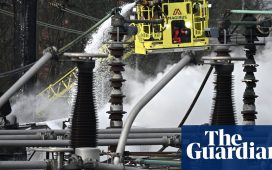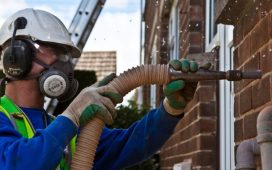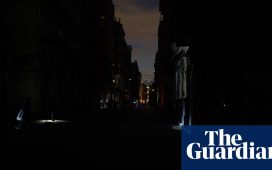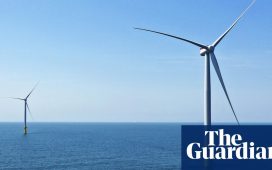Renewable energy is rolling out at record-breaking pace with billions of dollars being invested in new wind farms, solar arrays and battery storage.
In the United States, the wind industry now generates enough electricity to power more than 43 million homes, according to the Department of Energy, with more than 70,000 turbines spinning across 43 states.
But while it is one of the cheapest and cleanest energy sources, there is a growing problem. While most of a wind turbine can be reused, its enormous fiberglass blades are difficult to dispose of when they reach the end of a 20-25 year life span.
This has led to vast graveyards of these monster pieces of machinery. It’s estimated that 720,000 tons of blade material will be disposed of over the next 20 years in the US, and lawsuits are beginning to spring up over the dumping of blades.
Around the world, companies are beginning to figure out ways to resurrect them. In Denmark, parts of gigantic blades have been repurposed as bike sheds. In the west of Ireland, a company called BladeBridge is making pedestrian footbridges and cyclepaths out of sections. Decommissioned blades have been turned into playgrounds in the Netherlands. There is a growing sector in shredding fiberglass material to be added to make cement stronger and more durable.
What do you do with 8,000 defunct wind turbine blades?
In northeastern Ohio, a region with deep roots in the iron and steel industries, one company has come up with a quirky but relatively straightforward solution for blades.
Canvus cuts the blades into chunks – or “filets” as the company calls them – and transforms them into sturdy, outdoor furniture at their factory near Cleveland. Since production started in August, thousands of benches, planters and picnic tables have been sold across the states to be used in downtown public spaces, parks and school campuses.
Many of the pieces, which weigh 600-800lbs, have been painted by local artists with designs incorporating everything from dragonflies, sunflowers, and constellations of stars, to a pizza slice.
‘Filets’ of wind turbine blades laid out at the company in northeastern Ohio
(Canvus)
Brian Donahue, managing partner at Canvus, described the pieces as “functional art”.
”You’re sitting in a piece of art, having a cup of coffee with a loved one or a friend, enjoying the view… The artists are phenomenal to work with and it gives them a canvas that they’ve never painted on before,” he told The Independent.
He added: “There’s no facility like it in the world. It’s got a little of the Willy Wonka Chocolate Factory to it. We’re doing something that’s never been done.”
Canvus was founded three years ago by former commodities traders in the renewables industry. “No one really knew what to do with the fiberglass [blades],” Mr Donahue said. “We view ourselves as partners to the wind companies we worked with, and we knew they were struggling with the problem. The PR was awful [from] burying all these blades in the ground.
The Cleveland-based artist, Lacy Talley, paints one of Canvus’ sheltered seating spaces in a bright, bold palette
(Canvus)
Mike Sobeck, a Cleveland based artist, who has specialized in the art of pizza painting and does murals all over the greater Cleveland area, with his ‘pizza-slice’ bench
(Canvus)
“Yes, they are difficult to deal and some people just view them as trash but it’s a commodity… Instead of finding a marketplace, we created one of our own.”
The company name is drawn from the idea of “a canvas for all of us”, and Mr Donahue says that the goal is to make this a solution for the global wind industry. They are particularly adept at using the awkward “root end” sections which attach to the turbine. “No one else can destroy that, it can’t be ground down because it’s too thick,” Mr Donahue added.
The process begins by cutting blades, which are around 170ft (52metres), at the wind farms into smaller 40-50ft sections that are more easily transported on flat-beds to the factory. Most of the inventory currently comes from Iowa, the second largest US wind energy producer after Texas, and are supplied by the manufacturer, wind farm owner or a construction company responsible for blade disposal.
“It’s not too challenging to get the raw material,” Mr Donahue said. “There are times when we’re paid to take it based on priority situations, or it’s just delivered to us for free, but it’s a case by case basis.”
The sheltered bench in place at Every Child’s Playground in Avon, Ohio
(Canvus)
Canvus’ upcycled wind turbine blades
(Canvus)
At the Ohio facility, a special marble-countertop cutting tool, sourced in Italy, is roped around the sections to cut the “filets”. They end up in an array of sizes and shapes due to the taper of the blade. The company doesn’t alter the shapes after they are cut, meaning that it’s a low-energy intensive process.
Next, the pieces cleaned of the dirt and grease accumulated from their decades in the outdoors. At times blades are too badly damaged, from a lightning strike for example, and this material is sent off to a partner company to be ground down.
The majority that can be upcycled are then treated by specialized craftsmen who start by repairing scars on the blades that come from hailstones or being dragged along the ground. The edges are sealed to protect from glass or wooden splinters, and then the product is smoothed, similar to the process in an autobody repair shop. The benches are made from composite lumber incorporating various recycled plastics.
The final step is a coat of paint in a neutral colour, and if an artist is getting involved, then primer, too. Around 20 Cleveland artists have created original designs, some of which remained in the city including at the Great Lakes Science Center, and Every Child’s Playground in Avon.
The city of Austin, Texas recently placed an order which will be beautified by a group of local artists.
While the company currently deals in blades from land-based wind farms, Mr Donahue said that the blades used in offshore facilities, which are around 350ft (107m), wouldn’t be a problem. “As long as they get them to the shoreline, we can cut them up just like any other blade,” he said.
It’s also a source material that won’t be running out of any time soon. Between 3,000 and 8,000 blades are taken down every year in the US, and thanks to $370bn in clean energy investment from the US government’s Inflation Reduction Act, it’s estimated that this number will soar to more than 10,000 from 2025 to 2030.










